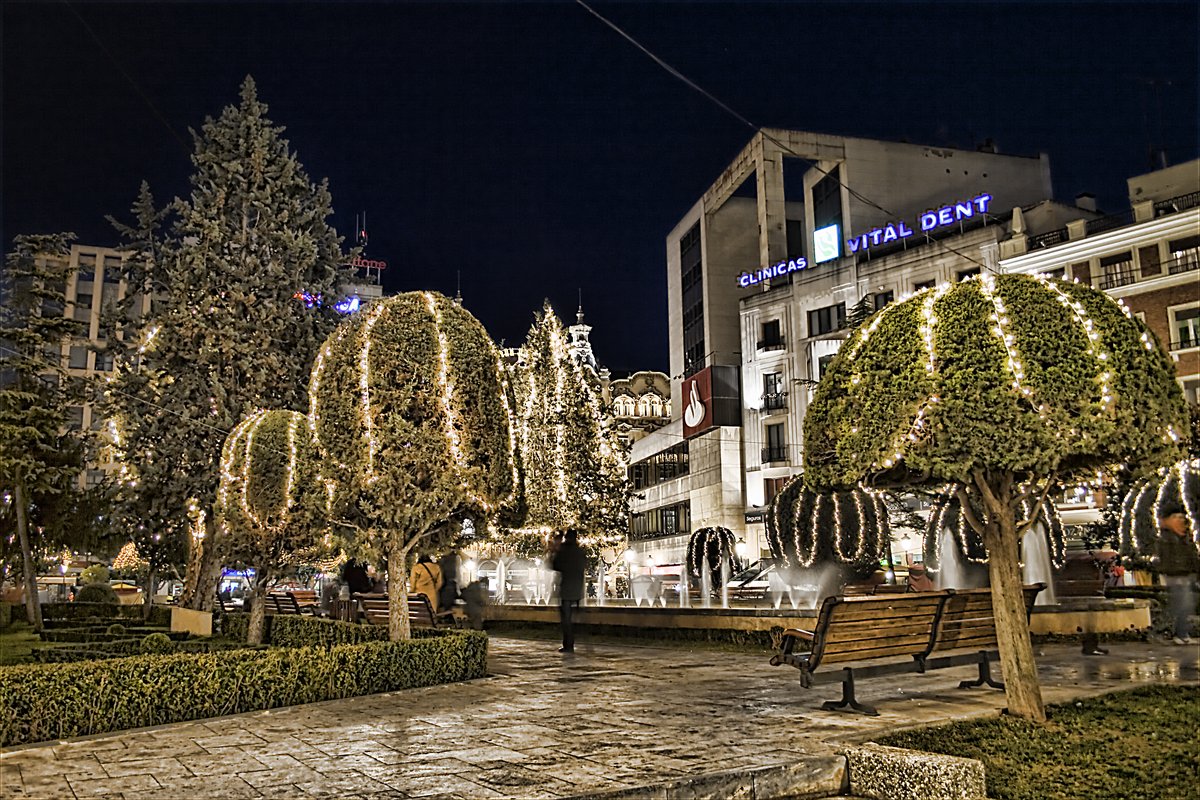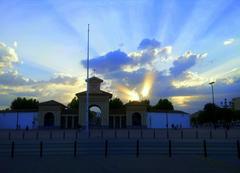
Complete Visitor’s Guide to Jardines del Altozano, Albacete, Spain
Date: 19/07/2024
Introduction
Nestled in the heart of Albacete, Spain, the Jardines del Altozano is a historical and cultural gem that offers visitors a serene escape from the urban hustle. This lush garden, with its rich history dating back to the late 19th century, reflects the city’s commitment to creating beautiful, livable spaces for its residents and visitors alike. Initially known as the ‘Paseo del Altozano,’ this area was transformed into a formal garden in 1887, featuring romantic and French garden design elements such as geometrically shaped flowerbeds, tree-lined walkways, and ornamental fountains (source). Over the years, the Jardines del Altozano has evolved to include modernist influences, expansions, and redesigns to accommodate growing numbers of visitors and host various events and celebrations (source). Today, it stands as a cherished green oasis and a symbol of Albacete’s cultural heritage, offering a range of recreational opportunities, from leisurely walks and bike rides to playgrounds for children and shaded benches for quiet contemplation. Visitors can explore its many features, including the iconic Monument to Peace, lush greenery, water features, sculptures, and artistic elements. The garden’s central location makes it easily accessible and a perfect starting point for exploring other nearby attractions in Albacete such as the Cathedral of Albacete and the Museo de la Cuchillería (source).
Table of Contents
- [Exploring the Jardines del Altozano - History, Visiting Hours, and Tickets](#exploring-the-jardines-del-altozano---history-visiting-hours-and-ticketsexploring-the-jardines-del-altozano---history-visiting-hours-and-tickets)
- [Early Beginnings - From Promenade to Public Garden](#early-beginnings---from-promenade-to-public-gardenearly-beginnings---from-promenade-to-public-garden)
- [A Garden Takes Shape - Design and Early Features](#a-garden-takes-shape---design-and-early-featuresa-garden-takes-shape---design-and-early-features)
- [A Symbol of Progress and Leisure](#a-symbol-of-progress-and-leisurea-symbol-of-progress-and-leisure)
- [20th Century - Evolution and Adaptation](#20th-century---evolution-and-adaptation20th-century---evolution-and-adaptation)
- [Present Day - A Cherished Green Oasis](#present-day---a-cherished-green-oasispresent-day---a-cherished-green-oasis)
- [Visitor Information - Visiting Hours, Tickets, and More](#visitor-information---visiting-hours-tickets-and-morevisitor-information---visiting-hours-tickets-and-more)
- [Unique Features and Events](#unique-features-and-eventsunique-features-and-events)
- [Frequently Asked Questions (FAQ)](#frequently-asked-questions-faqfrequently-asked-questions-faq)
- [Significance and Enduring Appeal](#significance-and-enduring-appealsignificance-and-enduring-appeal)
- [Conclusion](#conclusionconclusion)
- [References](#referencesreferences)
Exploring the Jardines del Altozano - History, Visiting Hours, and Tickets
The Jardines del Altozano stand as a testament to Albacete’s evolution, embodying a rich history intertwined with the city’s growth and changing urban landscape. This guide delves into the history, significance, and visitor information for one of Albacete’s most cherished public spaces.
Early Beginnings - From Promenade to Public Garden
The story of the Jardines del Altozano begins in the late 19th century, a period of significant urban development for Albacete. Prior to its transformation into a verdant space, the area was an open esplanade known as the “Paseo del Altozano.” This promenade served as a gathering place for residents, offering panoramic views of the city and the surrounding plains.
As Albacete prospered and expanded, the need for a dedicated public garden became apparent. In 1887, the decision was made to transform the Paseo del Altozano into a formal garden. This marked a turning point, signifying the city’s commitment to creating green spaces for its inhabitants.
A Garden Takes Shape - Design and Early Features
The design of the Jardines del Altozano drew inspiration from the popular garden styles of the time, incorporating elements of romanticism and French garden design. Key features included:
- Geometrically shaped flowerbeds: These added a sense of order and elegance, showcasing a variety of colorful blooms.
- Tree-lined walkways: The planting of trees, including plane and chestnut trees, provided shade and created inviting pathways for leisurely strolls.
- Ornamental fountains: Fountains, often adorned with sculptures, became central elements, adding a touch of grandeur and the soothing sound of water.
A Symbol of Progress and Leisure
The inauguration of the Jardines del Altozano in the late 19th century was met with great enthusiasm. The garden quickly became a beloved destination for residents from all walks of life. It represented a symbol of progress and modernity, showcasing Albacete’s commitment to creating a beautiful and livable city.
During this period, the Jardines del Altozano became a hub for social life and leisure activities. Families would gather for picnics under the shade of the trees, couples would stroll along the pathways, and children would play amidst the greenery. The garden provided a welcome respite from the bustling city center, offering a tranquil oasis for relaxation and recreation.
20th Century - Evolution and Adaptation
Throughout the 20th century, the Jardines del Altozano continued to evolve, reflecting changing trends and the needs of the growing city.
- Modernist influences: During the early 20th century, the garden saw the addition of modernist elements, such as the iconic Kiosco de la Música (Music Kiosk), a testament to the architectural styles of the era.
- Expansion and redesign: As Albacete expanded, so too did the Jardines del Altozano. The garden underwent several expansions and redesigns to accommodate the growing number of visitors and incorporate new features.
- A venue for events and celebrations: The Jardines del Altozano became a popular venue for a variety of events and celebrations, from concerts and theatrical performances to local festivals and markets.
Present Day - A Cherished Green Oasis
Today, the Jardines del Altozano remains one of Albacete’s most cherished public spaces. It continues to serve as a vibrant hub for social life, offering a welcome escape from the urban environment.
- A green lung for the city: The mature trees and lush vegetation provide a vital green lung for Albacete, helping to improve air quality and create a more pleasant urban environment.
- A place for recreation and relaxation: The garden offers a range of recreational opportunities, from leisurely walks and bike rides to playgrounds for children and shaded benches for quiet contemplation.
- A cultural and historical landmark: The Jardines del Altozano stands as a testament to Albacete’s history and cultural heritage, reflecting the city’s evolution over time.
Visitor Information - Visiting Hours, Tickets, and More
To make the most of your visit to the Jardines del Altozano, here are some essential details:
- Visiting Hours: The garden is open daily from 7:00 AM to 10:00 PM. Hours may vary during special events and holidays.
- Tickets: Entry to the Jardines del Altozano is free of charge. However, certain events and guided tours may require tickets, which can be purchased on-site or online through the official website.
- Accessibility: The garden is wheelchair accessible, with paved pathways and ramps throughout the area.
- Travel Tips: Consider visiting early in the morning or late in the afternoon to avoid the midday heat. Don’t forget to bring water, sunscreen, and comfortable walking shoes.
- Nearby Attractions: While in Albacete, explore other historical sites such as the Museo de Albacete and the Catedral de San Juan Bautista.
Unique Features and Events
- Special Events: Throughout the year, the Jardines del Altozano hosts a variety of events, including concerts, theatrical performances, and local festivals.
- Guided Tours: Take advantage of guided tours to learn more about the garden’s history, design, and significance.
- Photographic Spots: The garden offers numerous picturesque spots perfect for photography, from the ornate fountains to the tree-lined walkways.
Frequently Asked Questions (FAQ)
Q: What are the Jardines del Altozano visiting hours?
- A: The garden is open daily from 7:00 AM to 10:00 PM.
Q: Are there any ticket fees for entry?
- A: Entry is free, but some events and guided tours may require tickets.
Q: Is the garden accessible for wheelchair users?
- A: Yes, the garden is fully accessible with paved pathways and ramps.
Q: What other attractions are nearby?
- A: Nearby attractions include the Museo de Albacete and the Catedral de San Juan Bautista.
Significance and Enduring Appeal
The Jardines del Altozano holds a special place in the hearts of Albacete’s residents. Its significance extends beyond its physical beauty, encompassing:
- A Symbol of Identity: The garden is a source of pride for locals, representing the city’s commitment to creating a high quality of life for its inhabitants.
- A Place of Memories: For generations, the Jardines del Altozano has been a backdrop for countless personal memories, from childhood adventures to romantic encounters.
- A Testament to Urban Planning: The garden serves as a successful example of urban planning, demonstrating how green spaces can enhance the livability and appeal of a city.
As Albacete continues to evolve, the Jardines del Altozano will undoubtedly remain a cherished landmark, adapting to the changing needs of the city while preserving its historical charm and providing a vital green oasis for generations to come.
Conclusion
The Jardines del Altozano is more than just a public garden; it is a testament to Albacete’s historical evolution and a symbol of the city’s dedication to enhancing the quality of life for its residents and visitors. Over the years, it has adapted to the changing needs of the community while preserving its historical charm. From its early days as the ‘Paseo del Altozano’ to its current status as a beloved green space, the garden has played a significant role in the social and cultural life of Albacete. It offers a variety of attractions and features that cater to diverse interests, making it a must-visit destination for anyone exploring the city. Whether you’re interested in its rich history, lush flora, scenic views, or simply seeking a tranquil place to relax, the Jardines del Altozano provides an enriching and memorable experience. As Albacete continues to grow and evolve, this cherished landmark will undoubtedly remain a vital part of the city’s cultural and historical landscape, providing a green oasis for future generations to enjoy (source, source).
References
- Exploring the Jardines del Altozano - History, Visiting Hours, and Tickets, 2024, Author source
- Exploring Jardines del Altozano - Visiting Hours, Tickets, and Key Attractions in Albacete, 2024, Author source
- Visitor Guide to Jardines del Altozano - Best Times, Tickets, and Nearby Attractions in Albacete, 2024, Author source






